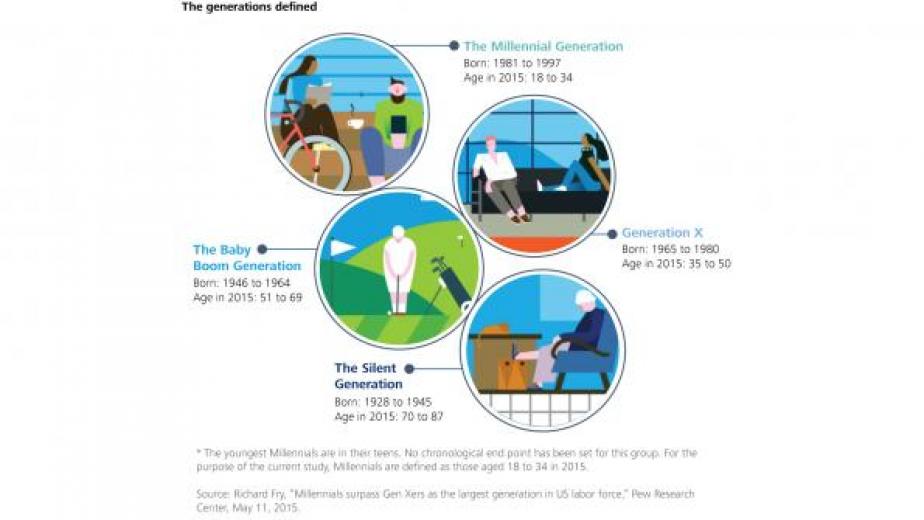1 9
1 9
Net wealth in the United States will grow from about $72 trillion in 2015 to $120 trillion by 2030. Household assets will increase from $87 trillion to nearly $140 trillion. Nearly $64 trillion of this growth will be in investable financial assets. Assuming 50 percent penetration of wealth management services, and fees ranging from 50 bps to 75 bps, that means that in 2030 between $150 billion and $240 billion in total fees could be available.
Based on the current example set by the silent generation, who despite their rapidly advancing age remain prime financial services candidates even into their mid 80s, Boomers should similarly retain much of their current financial heft through 2030. Boomers’ share of net household wealth is actually still increasing, and will peak at 50.2 percent by 2020, then decline to 44.5 percent by 2030, falling off even more quickly thereafter.
Takeaway: Any material move away from Boomer clients in the near future is likely premature. However, as Boomers age and move further into the drawdown phase, advisors must be ready to introduce elements like estate planning, insurance and long-term care. Product portfolios and pricing models should change as well.
The study identifies three factors that drive financial asset growth for each generation: 1. Personal savings, which drive the acquisition of new assets; 2. Portfolio returns, which represent the current value of existing assets; and 3. Drawdowns, which reflect the spending of assets in retirement.
Gen-X finds itself at the most advantageous intersection of these factors, moving into the highest paying positions and actively saving for retirement while experiencing few drawdowns. Their financial assets will grow to $22 billion by 2030, a compound annual growth rate of over 11 percent. This represents growth from under 14 percent of total net wealth in 2015 to nearly 31 percent by 2030.
Takeaway: Generation X’s wealth will take time to reach the levels of the Boomers, mainly due to the generation’s small size and the fact that this group bore the brunt of the 2008 financial crisis. However, about 37 percent of Generation X reports having more than $100,000 in investable assets. They are also the largest investors in residential property by value, both of which bode well for their prospects. Due to a combination of factors, debt and retirement remain major concerns for this group and, as such, are areas where attentive advisors can create value.
The Millennial generation will experience the fastest growth rate of net wealth, driven largely by increasing participation in the workforce and increasing salaries of the oldest, as they’re promoted. Overall, Millennials’ financial assets are projected to grow from $1.4 trillion in 2015 to $11.3 trillion in 2030, a compound annual growth rate of nearly 15 percent. However, despite it’s rapid growth, the generation’s share of national household wealth will remain below 20 percent.
Takeaway: Millennials’ rapidly increasing wealth is starting from a low base, which means it may be a while before they become viable targets for wealth planners. Though just 14 percent of Millennials say they have over $100,000 in investable assets, they now boast the second-highest share of home purchases by value. This generation has also demonstrated a willingness to engage with technology. New data indicates that Millennials are increasingly factoring the strength of a bank’s digital offerings into their choices. Advisors must be willing and able to engage with this segment in the digital space.
With residential property alone currently making up more than 58 percent of nonfinancial assets, the study predicts that home ownership will remain a pillar. Nonfinancial assets overall are projected to grow from about $52 trillion in 2015 to nearly $77 trillion by 2030, a compound annual growth rate of 2.7 percent. Home prices may remain somewhat subdued as a result of slowing population growth potentially causing supply to exceed demand.
US household debt is projected to grow at a slower pace than assets, from $14.4 trillion in 2015 to over $20.5 trillion in 2030, a compound annual growth rate of 2.4 percent, which will reduce the debt-to-asset ratio of American households from 17 percent in 2015 to 14.6 percent in 2030.
Baby Boomers’ debt, currently estimated at $6.1 trillion, is projected to peak within the next few years and then steadily decrease, reaching $5.3 trillion by 2030. Generation X and Millennials, on the other hand, will experience a steep increase in debt, 4.3 percent and 6.5 percent, respectively, in the same period. Nevertheless, their debt-to-asset ratios will drop. Increasing income and savings will enable them to acquire new assets to outstrip their growing debt. That being said, student debt will weigh on a significant number of Millennial and Generation X households. This debt load may negatively affect retirement savings.
Between today and 2030, nearly $24 trillion will be transferred in bequests (after taxes and charitable giving), reflecting spousal, inter-, and intra-generational wealth transfers.
Takeaway: The Silent Generation controls nearly $24 trillion in wealth today and are largely the ones who will be making the aforementioned bequests between now and 2030. Reinforcing your relationship with these clients by tailoring products and services to assist in this inevitable transfer, as well as attempting to engage with any potential heirs, are both imperative for advisors who want to keep these assets under their management.
Net household wealth in 2030 could be as low as $108 trillion or as high as $124 trillion, depending on the long-term performance of the U.S. economy. The varying savings and consumer spending behaviors represented in the above scenarios will also meaningfully affect the relative performance of asset classes.

